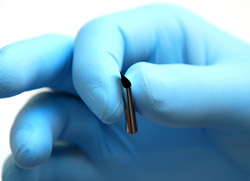May 4 2009
Materials researchers at Penn State University have reported the highest known breakdown strength for a bulk glass ever measured. Breakdown strength, along with dielectric constant, determines how much energy can be stored in an insulating material before it fails and begins to conduct electricity. A bulk glass with high breakdown strength and high dielectric constant would make an ideal candidate for the next generation of high energy density storage capacitors to power more efficient electric vehicles, as well as other portable and pulsed power applications.
 Flexible alkali-free barium boroaluminosilicate glass with a thin coating of platinum to enhance visibility. April Benson MRI
Flexible alkali-free barium boroaluminosilicate glass with a thin coating of platinum to enhance visibility. April Benson MRI
The highest dielectric breakdown strengths for bulk glasses are typically in the 4-9MV/cm range. The breakdown strength for the tested samples were in the 12MV/cm range, which in conjunction with a relatively high permittivity, resulted in energy densities of 35 J/cm3, as compared to a maximum energy density of 10 J/cm3 for polypropylene, the most common dielectric for pulsed power applications.
“For a bulk glass, this is extraordinary,” says Nick Smith, a Ph.D. candidate in materials science and engineering at Penn State, who is lead author on the report and performed the testing. Smith used samples of 50 micron-thick commercial glass, which he etched for testing with hydrofluoric acid until the samples were only 10-20 microns thick. The resulting glass was so thin it could be flexed like a piece of plastic film, yet so delicate it could easily disintegrate if mishandled. The thinner the glass, the more electric field can be applied before failure.
The etched glass was placed in a polymer fluid for testing and up to 30,000 volts were applied. When the breakdown point was reached, electricity began to flow through the glass suddenly, with a flash and a bang that resembles a lightning bolt conducting through air. The polymer fluid was used to contain the lightning. In each case, failure occurred within 40 to 80 seconds.
The bulk glass tested is an alkali-free barium boroaluminosilicate glass produced in large quantities for flat panel displays and microelectronics packaging. Its high energy storage capability is attributed to the highly polarizable barium atoms, which contribute to the enhanced permittivity, and the alkali-free composition, which inhibits energy loss. Also a factor is the nearly defect-free quality of the glass. The specific process used to manufacture this glass yields a more flaw-free material, especially at the surface, which further enhances resistance to breakdown. Sheets of 30-micron-thick glass, which are expected to be available commercially in the near future, are likely to have even higher breakdown strength than the etched glass due to an even more uniform flaw-free surface. “This opens a potentially new market for glass,” says Smith. “We are always looking for new functionalities in glass. Ideally, manufacturing will get to a point where they can make any size sheet they need for any size capacitor.”
Contributing author Michael Lanagan points out that engineering challenges remain as they scale up from the small size glass capacitors tested to those ready for commercial production. “We’ll lose some of the energy density as we increase in volume," he says, “but we should still end up with some remarkable capacitance.”
A paper reporting their results, titled “Glass as a High Energy Density Dielectric Material,” is currently available online and in the June 2009 edition of Materials Letters. In addition to Smith, the authors are graduate student Badri Rangarajan, engineering science and mechanics, Michael T. Lanagan, associate professor of engineering science and mechanics, and Carlo G. Pantano, distinguished professor of materials science and engineering.
This research was supported by the Office of Naval Research, the Pennsylvania State University Materials Research Institute, the National Science Foundation, the Center for Optical Technologies, and Bayer MaterialScience LLC.
The Materials Research Institute coordinates the research of more than 200 materials scientists at Penn State. The Millennium Science Complex, now under construction, is a $225M facility for materials and life sciences research scheduled to open at University Park in summer 2011.